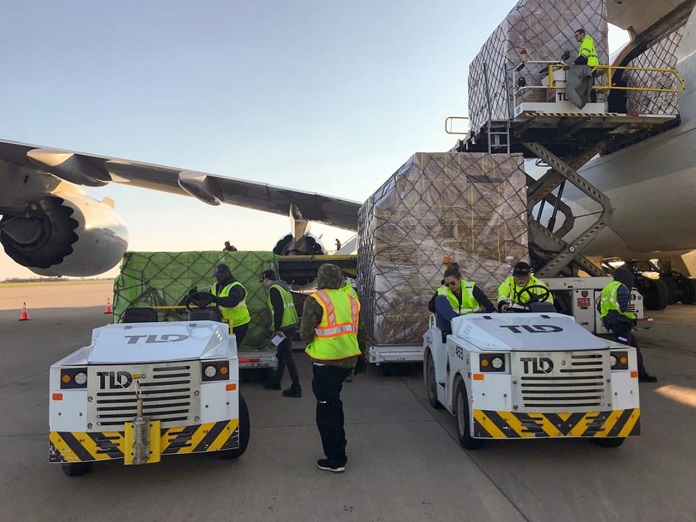
TSA will approve new systems to screen air cargo and work closely with industry partners to ensure that new technologies are effective and reliable.
The Transportation Security Administration (TSA) has published its five-year strategic vision for modernizing, streamlining, and further securing air cargo transportation operations.
In the past decade, the rapid increase of air cargo volume, due to the rise of e-commerce and customer demands for expedited delivery of goods, has substantially contributed to the air cargo system working at its full capacity. Most recently, the effects of the COVID-19 pandemic placed additional demands on supply chains that were already working at capacity.
In the 2010 bomb plot in Yemen, explosives were concealed within printers and shipped via air cargo but were discovered en route to the United States. Similarly, in the 2017 Australia bomb plot, explosives were shipped from Turkey to Australia by air cargo in an attempt to attack a passenger aircraft. A 2018 plot involving parcel bombs resulted in two deaths. In that incident, the lone actor attempted to ship two devices via a U.S. cargo carrier with one device detonating in a processing facility and the other being rendered safe during processing at a second facility.
Adversaries continue to threaten the air cargo system to carry out terrorist plots and use the air cargo supply chain to ship dangerous and potentially deadly items for pre-operational planning. Today, the air cargo system also faces emerging risks, including a proliferation of cyber threats and the increasingly pervasive use of unmanned aircraft systems
The new Air Cargo Security Roadmap is designed to help TSA and air cargo industry stakeholders identify and address emerging threats and ensure the efficient flow of commerce. The roadmap represents an extensive collaboration with trusted stakeholders within the air cargo industry. These include representatives from passenger carriers, all-cargo carriers, integrated carriers, indirect air carriers, shippers, ground handlers, partner government agencies, and industry associations.
The stakeholders agreed to the need to focus on a number of high-priority areas, including expanding risk-based screening and analysis on domestic all-cargo flights, improving information sharing and screener training, enhancing the air cargo screening technology environment, improving the effectiveness of security standards, and responding to the complexities of the evolving air cargo system.
The new roadmap aligns with the TSA Strategy (2018-2026) and the Administrator’s Intent 2.0. To achieve the roadmap’s goals and objectives, TSA will continue to leverage innovative air cargo screening technologies and modernize our policies to reflect best practices in security.
The roadmap seeks to advance the capabilities for enhanced, risk-based screening; expand knowledge and information sharing between TSA and industry; enhance the air cargo industry’s technology posture to support security-enhancing innovation within the supply chain; and modernize air cargo policy to adapt to new technologies, flex with changing dynamics in the supply chain and address new threats.
Operational security effectiveness will be measured using TSA inspections and covert testing to evaluate security program holders’ adherence to regulatory requirements and their actions taken to self-evaluate their security effectiveness and ability to identify security gaps. TSA will also engage with its foreign partners and international organizations to address vulnerabilities and other threats that originate beyond U.S. borders.
In July, the Government Accountability Office (GAO) found weaknesses in TSA’s analysis of computed tomography imaging technology. In response, TSA told GAO that it was expanding performance measurement regarding adherence to air cargo security requirements that would move beyond measuring the level of air carriers’ compliance. Officials told GAO then that TSA was working toward using air cargo covert testing at foreign airports as a potential proxy outcome measure for assessing the effectiveness of security requirements in preventing threats on flights to the United States.
According to the roadmap, TSA – through a qualification and testing program – will approve new systems to screen air cargo and work closely with industry partners to ensure that new technologies are effective and reliable. TSA says the air cargo marketplace lacks key incentives to encourage investment in security technologies, such as artificial intelligence and machine learning.
As a result, opportunities for innovation that could improve security effectiveness may be limited. TSA will seek new opportunities to establish partnerships with air cargo screening technology vendors and other capability providers and explore opportunities for funding to support and expand both current and future capability pipelines. As part of the roadmap’s initiatives, TSA will work with the industry to understand how to best encourage the development of new security technology and other capabilities.
The roadmap includes a review of cargo shipper vetting and will also consider options that allow the all-cargo industry to propose alternate risk-based and data-driven security and screening procedures for air cargo screening operations.
TSA will also assess the current state of training for air cargo screening and associated requirements. Historically, the industry has been responsible for the hiring, training, and testing of its air cargo screeners. However, TSA will look to support screener training to address challenges with consistency, uniformity, and availability of threat-driven training materials and protocols.
According to the roadmap, information and intelligence will be shared through the Aviation Domain Intelligence Integration & Analysis Cell (ADIAC) among primary stakeholders to enable agile, data-driven decision making.
The new objectives also include provision for TSA to conduct a holistic review of air cargo security programs to determine how it might update or replace them to better reflect the complexities of the modern supply chain, mitigate cybersecurity threats, and to consider how best to conduct future, recurring reviews.
“I am proud of the work and collaboration that led to this roadmap for improving the security of our nation’s air cargo system,” said TSA Administrator David Pekoske. “When we collectively work toward common goals with a unified purpose, we tend to achieve greater results.”










